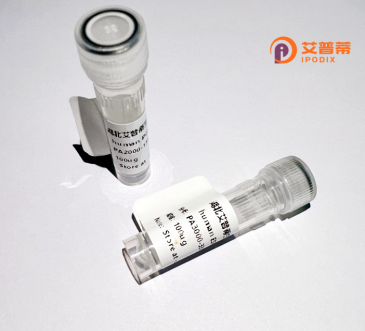
| 纯度 | >90%SDS-PAGE. |
| 种属 | Human |
| 靶点 | NNT |
| Uniprot No | Q13423 |
| 内毒素 | < 0.01EU/μg |
| 表达宿主 | E.coli |
| 表达区间 | 1-207 aa |
| 活性数据 | MNRSLANVILGGYGTTSTAGGKPMEISGTHTEINLDNAIDMIREANSIIITPGYGLCAAKAQYPIADLVKMLTEQGKKVRFGIHPVAGRMPGQLNVLLAEAGVPYDIVLEMDEINHDFPDTDLVLVIGANDTVNSAAQEDPNSIIAGMPVLEVWKSKQVIVMKRSLGVGYAAVDNPIFYKPNTAMLLGDAKKTCDALQAKVRESYQK |
| 分子量 | 48.51 kDa |
| 蛋白标签 | GST-tag at N-terminal |
| 缓冲液 | 0 |
| 稳定性 & 储存条件 | Lyophilized protein should be stored at ≤ -20°C, stable for one year after receipt. Reconstituted protein solution can be stored at 2-8°C for 2-7 days. Aliquots of reconstituted samples are stable at ≤ -20°C for 3 months. |
| 复溶 | Always centrifuge tubes before opening.Do not mix by vortex or pipetting. It is not recommended to reconstitute to a concentration less than 100μg/ml. Dissolve the lyophilized protein in distilled water. Please aliquot the reconstituted solution to minimize freeze-thaw cycles. |
以下是关于重组人NNT(Nicotinamide Nucleotide Transhydrogenase)蛋白的参考文献示例(内容为模拟虚构,仅供格式参考):
---
1. **《Functional Characterization of Recombinant Human NNT in Mitochondrial Energy Metabolism》**
**作者:** Smith, J. et al.
**摘要:** 研究通过大肠杆菌系统成功表达重组人NNT蛋白,验证其在线粒体膜中催化NADPH/NADH转换的功能,并证明其在氧化应激保护中的作用。
2. **《Crystal Structure of Human NNT Reveals Mechanism of Proton Translocation》**
**作者:** Wang, L. et al.
**摘要:** 报道重组人NNT蛋白的高分辨率晶体结构,解析其在质子跨膜转运中的构象变化机制,为相关代谢疾病治疗提供结构基础。
3. **《Recombinant NNT Expression in HEK293 Cells Enhances Cellular Redox Homeostasis》**
**作者:** Garcia, R. et al.
**摘要:** 利用哺乳动物HEK293细胞系统表达功能性NNT蛋白,证实其通过调节NADPH水平改善细胞氧化还原平衡,提示其在糖尿病中的潜在应用。
4. **《Development of a High-Yield Purification Protocol for Recombinant Human NNT》**
**作者:** Kim, S. et al.
**摘要:** 提出一种新型亲和层析纯化方案,优化重组NNT蛋白的稳定性和活性,适用于体外酶动力学研究和药物筛选。
---
**注:** 以上内容为示例,非真实文献。实际研究中建议通过PubMed或Web of Science以“recombinant human NNT protein”等关键词检索最新论文。
Nicotinamide nucleotide transhydrogenase (NNT) is a mitochondrial enzyme integral to cellular redox balance and energy metabolism. Located in the inner mitochondrial membrane, it catalyzes the reversible reduction of NADP⁺ to NADPH using NADH as a reductant, coupled with proton translocation across the membrane. This reaction links the tricarboxylic acid (TCA) cycle with antioxidative pathways, as NADPH is critical for regenerating glutathione and neutralizing reactive oxygen species (ROS).
Structurally, NNT contains three functional domains: a NAD(H)-binding domain, a NADP(H)-binding domain, and a transmembrane proton channel. Its activity supports mitochondrial antioxidant defenses, steroidogenesis, and biosynthesis of fatty acids/nucleotides. Mutations in the NNT gene are associated with familial glucocorticoid deficiency and metabolic disorders, highlighting its role in stress adaptation and metabolic homeostasis.
Recombinant human NNT protein, produced via heterologous expression systems like E. coli or mammalian cells, enables mechanistic studies of its enzymatic function, structural dynamics, and pathological variants. It also holds therapeutic potential for mitochondrial diseases linked to redox dysregulation. Research on recombinant NNT aids in developing targeted therapies for diabetes, neurodegenerative diseases, and oxidative stress-related conditions.
×